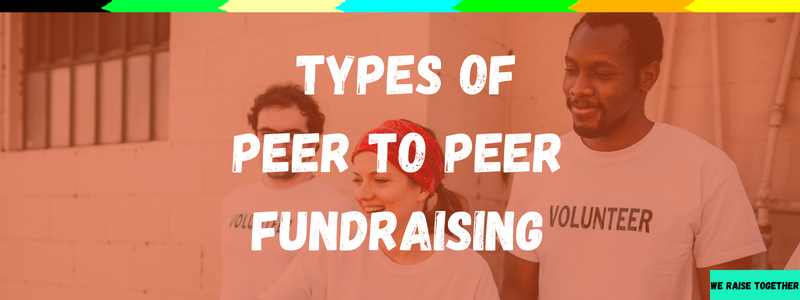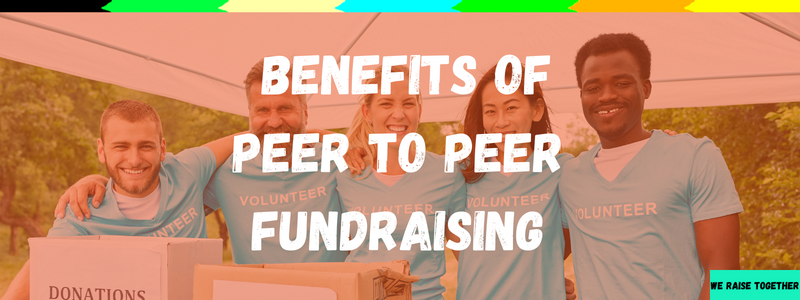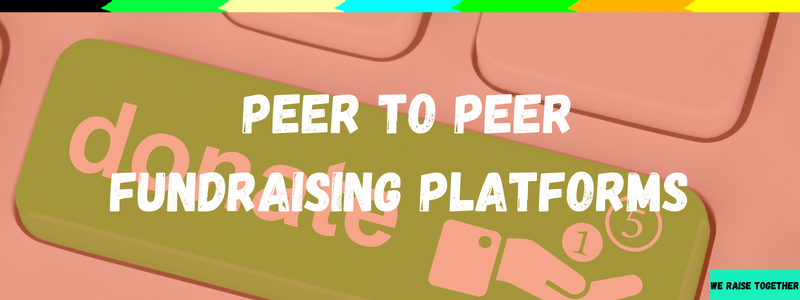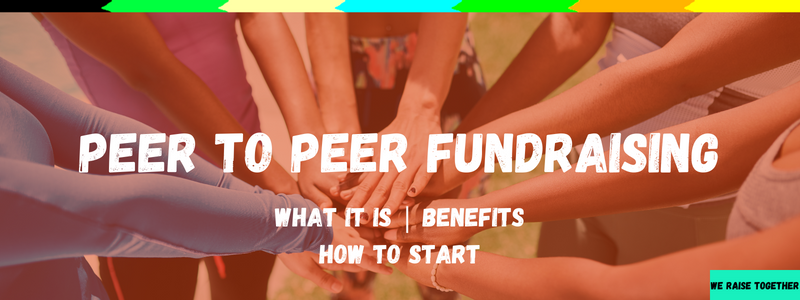Peer to peer fundraising allows people to fundraise by soliciting donations from their personal networks.
It’s a popular way to raise funds for nonprofits. In fact, according to Springly, 33% of nonprofits were using a P2P fundraising platform as of 2019.
Additionally, 14% of donors who gave in a campaign donated in a subsequent campaign, and the average gift was $91 as of 2020.
Clearly, this fundraising method can be quite effective!
So, in this ultimate guide, we’ll dive deeper into this fundraising idea, how it works, and the benefits it offers.
Table of Contents
- What Is Peer to Peer Fundraising?
- Is Peer to Peer Fundraising Effective?
- 7 Types of Peer to Peer Fundraising Campaigns
- 7 Benefits of Peer to Peer Fundraising
- How to Start A Successful Peer to Peer Fundraiser
What Is Peer to Peer Fundraising?
Peer to peer fundraising, also called P2P fundraising, relies on individuals to solicit donations from their social networks and personal contacts.
This differs from other campaigns relying solely on other fundraising methods, like foundation grants or corporate donations.
In P2P fundraising, supporters create their own campaign pages on behalf of a nonprofit organization. Then, they ask their friends, family, and colleagues to donate to their campaign.
This type of fundraising lets you to leverage the power of your supporters’ social networks, allowing you to reach a much wider audience.
Overall, it’s a powerful tool for nonprofits or schools looking to raise funds and share their cause.
By tapping into the power of social networks and empowering their supporters to become fundraisers, nonprofits can:
- Reach new donors
- Build stronger relationships with their supporters
- Make a bigger impact on the causes they care about
The Difference Between Peer to Peer Fundraising and Crowdfunding

While peer to peer fundraising and crowdfunding may seem similar at first glance, there are some key differences between the two.
Crowdfunding is a type of fundraising where individuals or companies raise money for a specific project or product through online platforms like Kickstarter or GoFundMe.
In crowdfunding, donors typically contribute money in exchange for rewards or perks. For example, they may get early access to a product.
On the other hand, peer to peer fundraising is focused on raising funds for a nonprofit organization or cause.
While there are some similarities between peer to peer fundraising and crowdfunding, the key difference lies in the focus on nonprofit causes versus individual projects.
Is Peer to Peer Fundraising Effective?
Peer to peer fundraising can be an effective strategy for nonprofit organizations of all sizes.
In fact, many nonprofits have found that these fundraisers are a great method to raise funds.
According to Peer To Peer Professional Forum, “nonprofits producing America’s top thirty peer to peer fundraising programs collectively increase fundraising revenue 18.8% in 2022.” Better yet, 93% of programs showed revenue gains.
One of the key reasons why P2P fundraising is so effective is that it leverages the power of social networks.
By empowering supporters to create their own fundraising pages and share them with their friends, family, and colleagues, you can tap into new networks of potential donors.
In addition to raising funds, peer to peer fundraising also helps you build stronger relationships with your supporters.
By giving supporters a sense of ownership over the fundraising process and empowering them to become advocates, you can build a community of dedicated donors.
Of course, like any strategy, their effectiveness depends on a variety of factors, including the:
- Organization’s fundraising goals
- Strength of its supporters’ networks
- Quality of its fundraising tools and resources
However, when implemented correctly, P2P fundraising is an amazing tool for nonprofits.
7 Types of Peer to Peer Fundraising Campaigns

There are many different types of peer to peer fundraising campaigns you can use to engage your supporters and raise funds.
Here are some of the most common types.
1. Event-Based Fundraising

Event-based campaigns are often used for events such as fun runs, charity concerts, or game nights.
Supporters create fundraising pages and solicit donations from their networks in support of their participation in the event.
These campaigns are awesome because they combine the excitement of a physical event with the power of social networks.
We’ll discuss some event-based P2P fundraising ideas later on.
2. Birthday and Milestone Fundraising

Milestone fundraising is centered around a someone’s birthday, anniversary, or other milestone event.
In this type of fundraiser, you create fundraising pages in honor of the occasion. Then, you encourage your friends and family to donate to the cause in lieu of gifts.
This type of campaign is great for celebrating a special occasion while supporting your nonprofit’s mission.
3. DIY Fundraising

DIY fundraising campaigns empower supporters to create their own fundraising ideas and initiatives. For example, supporters might:
- Host a bake sale
- Organize a benefit concert
- Create a virtual challenge and encourage their networks to donate to the cause in support of their efforts
If you have creative supporters, let them use their unique talents and skills to support your cause.
4. Virtual Fundraising/Peer to Peer Crowdfunding

P2P Crowdfunding, or virtual fundraising, combines the power of peer to peer fundraising with the principles of crowdfunding.
First, supporters create fundraising pages for a specific project or campaign. Then, they share their pages on social media and other channels to solicit donations.
If you’re a digital marketer or tech-savvy, this could become a profitable fundraising journey!
5. Time-Based Campaigns

Time-based campaigns involve organizing a 24-hour fundraising drive. For example, many organizations collect donations on Giving Day every year.
You can encourage your supporters to create fundraising pages and make donations on the day.
You might also consider offering incentives like matching gifts or prizes to encourage participation.
This type of campaign lets you motivate supporters with a sense of urgency!
6. Team Fundraising

Team fundraising involves organizing teams of supporters, such as employees of a company or members of a sports team.
Each team member creates a fundraising page and competes against each other to see who can raise the most money.
If your team members are competitive, this can be a great way to raise money for your cause.
7 Benefits of Peer to Peer Fundraising

In this section, we explore the key benefits of peer to peer fundraising.
We’ll also see how it can help your organization achieve its fundraising goals.
From expanding your donor base to building community, P2P fundraising offers a range of benefits that can make a serious impact.
1. Increases Reach & Expands Donor Base

Peer to peer fundraising is a powerful way to increase the reach of your mission and expand your donor base.
Because this model relies on supporters leveraging their social networks, your organization can tap into their networks.
This means they’ll spread the word about your cause and encourage their friends, family, and colleagues to donate.
When supporters create their personal fundraising pages, they can share their passion for your cause and the impact donating makes.
The personal touch is a great strategy for motivating people to give. It can also lead to a snowball effect as more people become aware of the work your organization does.
Additionally, the ability for supporters to share their pages on social media can greatly increase your visibility.
2. Boosts Engagement
Peer to peer fundraising is a great way to boost engagement with your supporters.
Supporters can personalize their fundraising pages with messages and share their passion for your cause.
This personal connection can be encourage potential donors to make a donation.
Additionally, as supporters fundraise on behalf of your organization, they become more invested in your cause.
This means they’re more likely to engage with your organization in other ways. For example, they might:
- Attend events
- Sign up for newsletters
- Volunteer their time
This increased engagement can lead to stronger relationships with your supporters and a greater sense of community around your cause.
Moreover, peer to peer fundraising can create a friendly competition among your supporters as they compete to raise the most funds.
3. Encourages Creativity

Peer to peer fundraising provides individuals with the opportunity to get creative. After all, it gives them a chance to showcase their unique talents in support of your cause.
As individuals create their fundraising pages, they have the freedom to customize the page with their own story, photos, and videos.
This personalization makes the fundraising page more meaningful to potential donors.
Some supporters may even choose to create unique challenges or events as part of their fundraising efforts, such as:
- Running a race
- Hosting a bake sale
- Organizing a trivia night
In addition to encouraging creativity among individual fundraisers, peer to peer fundraising can also inspire collaboration among groups of supporters.
For example, supporters may choose to create a team fundraising page, where they can work together to:
- Brainstorm ideas
- Set goals
- Inspire each other to reach their fundraising targets
4. Builds Community

Peer to peer fundraising is a powerful tool for building community around your cause.
By sharing personal stories on their fundraising pages, supporters feel more personally invested in your cause and connect with others sharing their passion.
As people fundraise and share their pages with friends and family, they can build a network of supporters.
This can create a sense of community among your supporters, as they work together towards a common goal.
In addition, peer to peer fundraising can also help you connect with those who’ve not previously been involved with your organization.
As fundraisers share their pages on social media, they can reach new audiences and expand the reach of your cause.
This can lead to new individuals becoming involved with your organization and feeling a sense of community around your cause.
5. Increases Donor Retention
Peer to peer fundraising can increase donor retention by creating a more personal experience for donors.
As supporters encourage others to back your cause, they become more connected to the impact of their support.
This can lead to increased donor retention, because supporters with a personal connection are more likely to continue offering support over time.
P2P fundraising involves supporters in the fundraising process and gives them a stake in the success of your organization.
This helps build stronger relationships with donors and increases their overall connection with your cause.
Additionally, the social aspect of peer to peer fundraisers can also help to increase donor retention.
As supporters build a sense of community around your cause, they are more likely to offer support over the long-term.
6. Lowers Costs

Peer to peer fundraisers are a cost-effective way to raise funds for your organization.
That’s because they allow you to leverage the networks of your supporters without incurring traditional marketing costs.
With peer to peer fundraising, your supporters are often responsible for:
- Creating and sharing their own fundraising pages
- Reaching out to their networks
- Collecting donations
This reduces the costs associated with other promotional methods, such as direct mail or paid ads.
In addition, peer to peer fundraisers can also help reduce the costs associated with organizing events.
Rather than organizing large-scale events yourself, you can encourage your supporters to organize their own events.
Alternatively, you could suggest they participate in existing events on your behalf.
7. Provides Valuable Data
Peer to peer fundraising can provide valuable data and insights into the preferences of your donors and supporters.
By collecting and analyzing data from your campaigns, you can gain a deeper understanding of your supporters, their networks, and what motivates them to give.
For example, you can track metrics such as:
- Number of donors and donations
- Average gift size
- Campaign success rates
You can also gather data on the most effective types of messages and campaigns, as well as the most effective channels in reaching donors.
Additionally, data can provide valuable insights into the demographics and geographic locations of your supporters.
This information can help you tailor your messaging to better resonate with your target audience. You can also use it to identify new potential donor pools.
How to Start A Successful Peer to Peer Fundraiser

In this section, we explore the key steps involved in starting a peer to peer fundraiser.
From defining your cause to celebrating your success, we’ll provide a comprehensive guide to get you started.
Read on to discover valuable insights and practical tips to help you achieve your fundraising goals.
1. Define The Cause

Defining the cause is the first step in starting a successful peer to peer fundraising campaign. This involves selecting a cause you’re passionate about and others will want to support.
You should research the cause and understand the impact it has on the community.
It’s also key to define the goals of your fundraising campaign.
For example, consider the amount of money you want to raise and how the funds will be used.
Having a clear understanding of the cause and its goals will help you create a more compelling P2P fundraising campaign.
2. Choose A Platform
Once you’ve defined your cause and set your fundraising goals, the next step is to choose a peer to peer fundraising platform.
There are many platforms available, each with its own set of features, fees, and support options.
When selecting a platform, consider factors such as:
- Ease of use
- The platform’s reputation and track record
- Fees charged by the platform
- The level of support provided by the platform
You should also consider the platform’s ability to integrate with your other fundraising tools. For example, think about your website or social media accounts.
Choosing the right platform is crucial to the success of your campaign, so take the time to research and compare different options before making a decision.
We’ll list a few of these platforms later on.
3. Create A Campaign

Your campaign should have a clear and concise description of:
- Your cause
- The amount of money you are looking to raise
- How the funds will be used.
You should also provide compelling visuals, such as images or videos. This will will help potential donors understand your cause and feel more emotionally connected to it.
Your campaign page should also include a clear call-to-action, encouraging supporters to make a donation.
Be sure to personalize your campaign by sharing your story and the impact the cause has had on you.
A well-crafted campaign page will help you stand out from other fundraising efforts and inspire people to donate.
4. Set A Fundraising Goal
Your fundraising goal should be ambitious but achievable. Take into consideration the size of your network and the potential for support from your target audience.
Be realistic about the amount of money you can raise, and factor in any fees charged by your fundraising platform.
Setting a clear and specific goal will help you stay focused and motivated throughout your campaign.
It will also help your supporters understand what you’re trying to achieve and how their contributions will make a difference.
Remember to periodically assess your progress and adjust your goals if necessary.
5. Customize Your Page
Customizing your campaign page is key to helping your peer to peer fundraiser stand out from the rest!
Your campaign page should be visually appealing and easy to navigate. Use high-quality images, videos, and other multimedia to tell your story and showcase your cause.
Also, ensure that your page is branded to reflect your cause or organization, and that it’s easy to understand.
Additionally, make sure you add social sharing buttons to encourage your supporters to share your campaign with their own networks.
6. Share Your Page

Sharing your page is essential for spreading the word about your peer to peer fundraising campaign.
You can promote your fundraiser within your personal network through email, social media, and other communication channels.
Consider asking your friends and family to share your campaign with their networks as well.
Additionally, think about reaching out to local media outlets or influential bloggers to help spread the word.
Social media hashtags and other digital marketing tactics can also help your campaign gain traction online.
Remember, keep your supporters engaged throughout the campaign by sharing regular updates on your progress and thanking them for contributions.
The more you share your campaign page, the more likely you are to reach your fundraising goals.
7. Engage Your Supporters
Engaging your supporters involves building relationships with them. It is also requires that you keep them motivated to donate and share your campaign with others.
To do this, provide regular updates on your progress and share success stories that illustrate the impact of your cause.
Also, consider hosting fundraising events, webinars, or other activities that help bring your supporters together and keep them engaged.
Finally, and importantly, thank your supporters for their contributions, and keep them informed about how their donations are making a difference.
8. Monitor Your Progress
You should regularly track your fundraising efforts to ensure that you’re on track to meet your goals.
To do this, use the data and insights provided by your fundraising platform to analyze your fundraising metrics. For example:
- Number of donations
- Average donation size
- Engagement level of your supporters
This information allows you to adjust your fundraising strategy and tactics as needed. So, make sure you monitor your progress and adjust your campaign strategy accordingly.
9. Celebrate Your Success

Once your peer to peer fundraising campaign has come to a close, it’s important to celebrate your success.
Most importantly, thank your supporters for their contributions.
This final step not only shows appreciation to your donors, but also creates a sense of community around your cause.
Here are a few ways to wrap up your campaign:
- Send thank-you notes: Send personalized thank-you notes to all of your supporters, thanking them for their contributions and support. This will help them feel appreciated and connected to your cause.
- Share success stories: Share stories and testimonials from the community you helped to show the real impact of your fundraising efforts. Use social media, email newsletters, and other communication channels to share these stories and highlight your achievements.
- Host a celebratory event: Consider hosting a celebratory event to thank your supporters in person. This could be a dinner, a party, or another type of gathering. Use this opportunity to share updates on your progress and thank your supporters for their contributions.
- Provide updates: Continue to provide updates on how the funds raised through your campaign are being used. Share stories and photos to illustrate the impact of your fundraising efforts and keep your supporters engaged with your cause.
- Recognize your top supporters: Finally, recognize your top supporters by highlighting their contributions and sharing their stories. This can help inspire others to get involved and support your cause as well.
10. Evaluate Your Results

Finally, evaluating a peer-to-peer fundraising campaign is key for identifying areas for improvement.
Here are some steps to take in evaluating your campaign once it’s over.
Review the goals
Before you start evaluating the campaign, go back to the goals you set at the beginning.
Look at the targets you set in terms of the amount to be raised, the number of donors, or any other metrics that were established.
The, assess whether these goals were reached or not.
Analyze the data
Gather all the data from the campaign, such as the:
- Number of donors
- Amount raised
- Average donation amount
- Social media reach
Use this data to identify the channels that worked best and the segments of donors that contributed the most.
Assess the impact
Evaluate the impact of the funds raised, and identify the programs or initiatives the campaign funded.
Them, measure their effectiveness in achieving their goals. This will help you understand how the funds raised are making a difference.
Solicit feedback
Get feedback from the participants, donors, and volunteers involved in the campaign. This will help you understand what worked well and what didn’t.
You can also ask them for suggestions on how to improve the campaign in the future.
Compare with previous campaigns
If you have run similar campaigns in the past, compare the results.
This can help you identify trends and patterns, informing future campaigns.
Share the results
Finally, share the results of the evaluation with all stakeholders, including the:
- Participants
- Donors
- Volunteers
- Wider community
This demonstrates transparency and accountability, helping to build trust and credibility for future campaigns.
Peer to Peer Fundraising Platforms

Peer-to-peer fundraising platforms are online tools enabling supporters to create their own fundraising pages.
Then, supporters share their pages with friends and family, encouraging them to donate.
P2P fundraiser platforms offer a range of features and tools to help organizations build successful fundraising campaigns. These may include:
- Customizable donation pages
- Social media integrations
- Team fundraising options
- Real-time analytics
- Mobile app support
One of the key benefits of P2P fundraising platforms is their ability to mobilize supporters and reach new audiences.
By taking advantage of personal connections, supporters can spread the word about a cause and inspire others to get involved.
This can even result in a viral effect, driving up donations and support for the cause.
The platforms also offer transparency and accountability. This allows donors to track the progress of campaigns in real-time and see how their contributions make an impact.
Many also offer robust reporting and analytics tools.
This gives organizations and individuals insights into their fundraising metrics, enabling them to fine-tune their strategies for maximum impact.
Some of the most popular peer to peer fundraising platforms include:
5 Peer to Peer Fundraising Event Ideas

Peer to peer fundraising events are a fun and effective way to engage supporters and raise funds for your cause.
Whether it’s a virtual event or an in-person gathering, the right event can help you connect with your community and inspire them to support your mission.
In this section, we’ll explore some creative and successful peer to peer fundraiser event ideas.
These ideas can help you generate support for your cause while building meaningful relationships with your donors.
1. Fun Run

A fun run, also called a Walkathon or Jogathon, is a non-competitive running or walking event.
Unlike a traditional race, fun runs prioritize the fun and social aspects of the event over competition and personal bests.
To make it even more memorable, consider choosing a fun run theme, like a Bubble Run or Santa Run.
Participants often wear costumes or themed outfits. The course may even include obstacles, color powder, or other fun features like Hot Chocolate stations.
They’re are a great way to engage people of all ages and fitness levels in a fun activity while also raising awareness for a cause.
2. Silent Auction

A silent auction is a peer to peer fundraising event where items or experiences are put up for bid.
Then, attendees place their bids on a sheet of paper or via a mobile app without any verbal communication.
The highest bidder at the end of the auction wins the item. Unlike traditional auctions, silent auctions are conducted without an auctioneer.
Silent auctions can include a wide variety of items, such as:
- Artwork
- Gift baskets
- Concert tickets
- Unique experiences
By earning money for the auctioned items and experiences, you can raise funds while providing donors with something of value.
3. Talent Show

A talent show is a P2P fundraising idea where participants display their unique skills, such as:
- Singing
- Dancing
- Playing an instrument
- Performing comedy
Participants can either compete against each other or perform in a non-competitive environment. Additionally, audiences can purchase tickets to the event, with proceeds going towards your cause.
Talent shows are a fun way to showcase the skills of your community while raising money for a good cause.
4. Charity Concert

A charity concert is a musical event featuring various performers who volunteer their time and talent to help awareness for your cause.
The proceeds generated from ticket sales and other fundraising methods during the event are donated to charity.
These concerts can range from small, local events to large-scale productions. Additionally, they can be organized by community groups, non-profit organizations, or individual artists.
5. Game Night

A game night is a P2P fundraising idea where participants come together to play various games while raising funds.
These events can include:
- Traditional board games
- Card games
- Video games
Participants can either pay a flat fee to attend or make donations throughout the night to support the cause.
These events are an awesome way to support a common cause while having fun and building community.
Should You Start A P2P Fundraising Campaign?
Peer to peer fundraising helps increase your reach, expand your donor base, and lower costs.
Better yet, you get to engage your supporters and build community around your cause.
While they require focus and dedication, they’re a powerful method for fundraising.
Most importantly, they can help you make a real difference in your community.
So, why not start your own P2P fundraiser today?
Fill out this form and we’ll help you get started!

